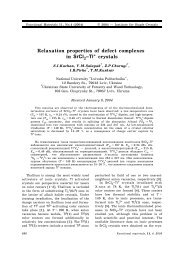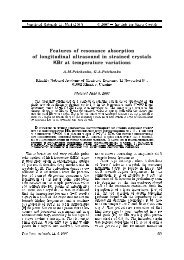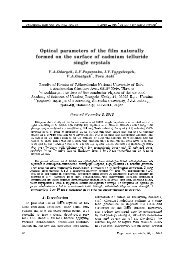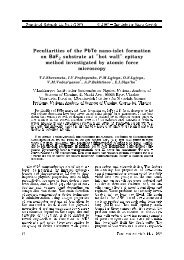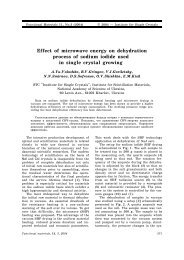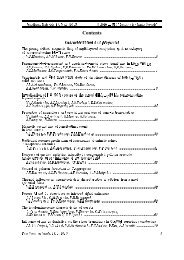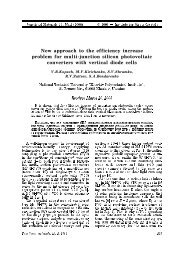- Page 3 and 4: 10 th Conference on Methods and App
- Page 5 and 6: Welcome to the Attendants of MAF 10
- Page 7 and 8: Scientific Programme Committee A. U
- Page 9 and 10: Table of Contents Welcome 3 Sponsor
- Page 11 and 12: 12:30 - 13:30 Lunch Break 13:30 - 1
- Page 13: 16:00 - 16:30 Gabor PATONAY (Atlant
- Page 17 and 18: Abstracts: Lectures LECT-1 Single b
- Page 19 and 20: Abstracts: Lectures LECT-3 Homo-FRE
- Page 21 and 22: Abstracts: Lectures LECT-5 Characte
- Page 23 and 24: Abstracts: Lectures LECT-7 Specific
- Page 25 and 26: Abstracts: Lectures LECT-9 Confocal
- Page 27 and 28: Abstracts: Lectures LECT-11 NIR-to-
- Page 29 and 30: Abstracts: Lectures LECT-13 Substra
- Page 31 and 32: Abstracts: Lectures LECT-15 Multico
- Page 33 and 34: Abstracts: Lectures LECT-17 The flu
- Page 35 and 36: Abstracts: Lectures LECT-19 Detecti
- Page 37 and 38: Abstracts: Lectures LECT-21 Ligand-
- Page 39 and 40: Abstracts: Lectures LECT-23 Two-foc
- Page 41: Abstracts: Lectures LECT-25 Nano-em
- Page 45 and 46: Abstracts: Lectures LECT-29 Novel f
- Page 47 and 48: Abstracts: Lectures LECT-31 Lumines
- Page 49 and 50: Abstracts: Lectures LECT-33 Two-pho
- Page 51 and 52: Abstracts: Lectures LECT-35 Europiu
- Page 53 and 54: Abstracts: Lectures LECT-37 Upconve
- Page 55 and 56: Abstracts: Lectures LECT-39 Recent
- Page 57 and 58: Abstracts: Lectures LECT-41 Design
- Page 59 and 60: Abstracts: Lectures LECT-43 Fluores
- Page 61: Abstracts: Lectures LECT-45 Charact
- Page 65 and 66: Abstracts Poster - Part I: Fluoresc
- Page 67 and 68: Abstracts Poster - Part I: Fluoresc
- Page 69 and 70: Abstracts Poster - Part I: Fluoresc
- Page 71 and 72: Abstracts Poster - Part I: Fluoresc
- Page 73 and 74: Abstracts Poster - Part I: Fluoresc
- Page 75 and 76: Abstracts Poster - Part I: Fluoresc
- Page 77 and 78: Abstracts Poster - Part I: Fluoresc
- Page 79 and 80: Abstracts Poster - Part I: Fluoresc
- Page 81 and 82: Abstracts Poster - Part I: Fluoresc
- Page 83 and 84: Abstracts Poster - Part I: Fluoresc
- Page 85 and 86: Abstracts Poster - Part I: Fluoresc
- Page 87 and 88: Abstracts Poster - Part I: Fluoresc
- Page 89 and 90: Abstracts Poster - Part I: Fluoresc
- Page 91 and 92: Abstracts Poster - Part I: Fluoresc
- Page 93 and 94:
Abstracts Poster - Part I: Fluoresc
- Page 95 and 96:
Abstracts Poster - Part I: Fluoresc
- Page 97:
Abstracts Poster - Part I: Fluoresc
- Page 101 and 102:
Abstracts Poster - Part II: Imaging
- Page 103 and 104:
Abstracts Poster - Part II: Imaging
- Page 105 and 106:
Abstracts Poster - Part II: Imaging
- Page 107 and 108:
Abstracts Poster - Part II: Imaging
- Page 109 and 110:
Abstracts Poster - Part II: Imaging
- Page 111 and 112:
Abstracts Poster - Part II: Imaging
- Page 113 and 114:
Abstracts Poster - Part II: Imaging
- Page 115 and 116:
Abstracts Poster - Part II: Imaging
- Page 117 and 118:
Abstracts Poster - Part II: Imaging
- Page 119 and 120:
Part III Probes, Labels and Sensors
- Page 121 and 122:
Abstracts Poster - Part III: Probes
- Page 123 and 124:
Abstracts Poster - Part III: Probes
- Page 125 and 126:
Abstracts Poster - Part III: Probes
- Page 127 and 128:
Abstracts Poster - Part III: Probes
- Page 129 and 130:
Abstracts Poster - Part III: Probes
- Page 131 and 132:
Abstracts Poster - Part III: Probes
- Page 133 and 134:
Abstracts Poster - Part III: Probes
- Page 135 and 136:
Abstracts Poster - Part III: Probes
- Page 137 and 138:
Abstracts Poster - Part III: Probes
- Page 139 and 140:
Abstracts Poster - Part III: Probes
- Page 141 and 142:
Abstracts Poster - Part III: Probes
- Page 143 and 144:
Abstracts Poster - Part III: Probes
- Page 145 and 146:
Abstracts Poster - Part III: Probes
- Page 147 and 148:
Abstracts Poster - Part III: Probes
- Page 149 and 150:
Abstracts Poster - Part III: Probes
- Page 151 and 152:
Abstracts Poster - Part III: Probes
- Page 153 and 154:
Abstracts Poster - Part III: Probes
- Page 155 and 156:
Abstracts Poster - Part III: Probes
- Page 157 and 158:
Abstracts Poster - Part III: Probes
- Page 159 and 160:
Abstracts Poster - Part III: Probes
- Page 161 and 162:
Abstracts Poster - Part III: Probes
- Page 163 and 164:
Abstracts Poster - Part III: Probes
- Page 165 and 166:
Abstracts Poster - Part III: Probes
- Page 167 and 168:
Abstracts Poster - Part III: Probes
- Page 169 and 170:
Abstracts Poster - Part III: Probes
- Page 171 and 172:
Abstracts Poster - Part III: Probes
- Page 173 and 174:
Abstracts Poster - Part III: Probes
- Page 175 and 176:
Part IV Fluorescence Correlation an
- Page 177 and 178:
Abstracts Poster - Part IV: Fluores
- Page 179 and 180:
Abstracts Poster - Part IV: Fluores
- Page 181 and 182:
Abstracts Poster - Part IV: Fluores
- Page 183 and 184:
Abstracts Poster - Part IV: Fluores
- Page 185 and 186:
Abstracts Poster - Part IV: Fluores
- Page 187 and 188:
Abstracts Poster - Part IV: Fluores
- Page 189 and 190:
Abstracts Poster - Part IV: Fluores
- Page 191 and 192:
Abstracts Poster - Part IV: Fluores
- Page 193 and 194:
Abstracts Poster - Part IV: Fluores
- Page 195 and 196:
Abstracts Poster - Part IV: Fluores
- Page 197 and 198:
Abstracts Poster - Part IV: Fluores
- Page 199 and 200:
Abstracts Poster - Part IV: Fluores
- Page 201 and 202:
Abstracts Poster - Part IV: Fluores
- Page 203 and 204:
Abstracts Poster - Part IV: Fluores
- Page 205 and 206:
Part V Upconversion and 2-Photon Ex
- Page 207 and 208:
Abstracts Poster - Part V: Upconver
- Page 209 and 210:
Abstracts Poster - Part V: Upconver
- Page 211 and 212:
Abstracts Poster - Part V: Upconver
- Page 213 and 214:
Abstracts Poster - Part V: Upconver
- Page 215 and 216:
Part VI Nanomaterials 213
- Page 217 and 218:
Abstracts Poster - Part VI: Nanomat
- Page 219 and 220:
Abstracts Poster - Part VI: Nanomat
- Page 221 and 222:
Abstracts Poster - Part VI: Nanomat
- Page 223 and 224:
Abstracts Poster - Part VI: Nanomat
- Page 225 and 226:
Abstracts Poster - Part VI: Nanomat
- Page 227 and 228:
Abstracts Poster - Part VI: Nanomat
- Page 229 and 230:
Abstracts Poster - Part VI: Nanomat
- Page 231 and 232:
Abstracts Poster - Part VI: Nanomat
- Page 233 and 234:
Abstracts Poster - Part VI: Nanomat
- Page 235 and 236:
Part VII Other Materials 233
- Page 237 and 238:
Abstracts Poster - Part VII: Other
- Page 239 and 240:
Abstracts Poster - Part VII: Other
- Page 241 and 242:
Abstracts Poster - Part VII: Other
- Page 243 and 244:
Abstracts Poster - Part VII: Other
- Page 245 and 246:
Abstracts Poster - Part VII: Other
- Page 247 and 248:
Abstracts Poster - Part VII: Other
- Page 249 and 250:
Part VIII Biophysics 247
- Page 251 and 252:
Abstracts Poster - Part VIII: Bioph
- Page 253 and 254:
Abstracts Poster - Part VIII: Bioph
- Page 255 and 256:
Abstracts Poster - Part VIII: Bioph
- Page 257 and 258:
Abstracts Poster - Part VIII: Bioph
- Page 259 and 260:
Abstracts Poster - Part VIII: Bioph
- Page 261 and 262:
Abstracts Poster - Part VIII: Bioph
- Page 263 and 264:
Abstracts Poster - Part VIII: Bioph
- Page 265 and 266:
Abstracts Poster - Part VIII: Bioph
- Page 267 and 268:
Abstracts Poster - Part VIII: Bioph
- Page 269 and 270:
Abstracts Poster - Part VIII: Bioph
- Page 271 and 272:
Abstracts Poster - Part VIII: Bioph
- Page 273 and 274:
Abstracts Poster - Part VIII: Bioph
- Page 275 and 276:
Abstracts Poster - Part VIII: Bioph
- Page 277 and 278:
Part IX Fluorescence in Biology, Me
- Page 279 and 280:
Abstracts Poster - Part IX: Biology
- Page 281 and 282:
Abstracts Poster - Part IX: Biology
- Page 283 and 284:
Abstracts Poster - Part IX: Biology
- Page 285 and 286:
Abstracts Poster - Part IX: Biology
- Page 287 and 288:
Abstracts Poster - Part IX: Biology
- Page 289 and 290:
Abstracts Poster - Part IX: Biology
- Page 291 and 292:
Abstracts Poster - Part IX: Biology
- Page 293 and 294:
Abstracts Poster - Part IX: Biology
- Page 295 and 296:
Abstracts Poster - Part IX: Biology
- Page 297 and 298:
Abstracts Poster - Part IX: Biology
- Page 299 and 300:
Abstracts Poster - Part IX: Biology
- Page 301 and 302:
Abstracts Poster - Part IX: Biology
- Page 303 and 304:
Abstracts Poster - Part IX: Biology
- Page 305 and 306:
Abstracts Poster - Part IX: Biology
- Page 307 and 308:
Abstracts Poster - Part IX: Biology
- Page 309 and 310:
Abstracts Poster - Part IX: Biology
- Page 311 and 312:
Abstracts Poster - Part IX: Biology
- Page 313 and 314:
Advertisements 311
- Page 319:
Leica_AM TIRF MC_en_148x210_Eurol:L
- Page 323:
Leica_TCS_SPE_eng_148x210_Eurol:Lei
- Page 327:
DIN EN ISO 9001 by Single photon co
- Page 335:
VARIAN, INC. Varian Eclipse Fluores
- Page 339 and 340:
Author Index Author Index A Abbruzz
- Page 341 and 342:
Author Index Gregor, I. 37 Greiner,
- Page 343 and 344:
Author Index Miller, L.W. 171 Minut
- Page 345:
Author Index Tauc, P. 191 Tearney,



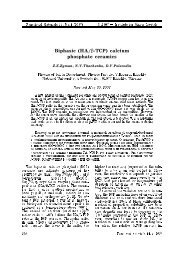
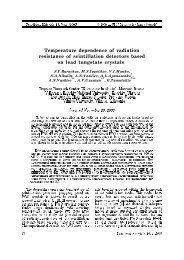
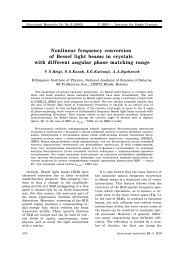
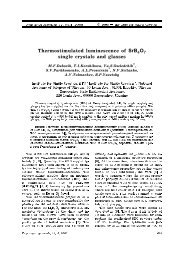

![Changes in crystalli] ation conditions when growing large single ...](https://img.yumpu.com/23526254/1/184x260/changes-in-crystalli-ation-conditions-when-growing-large-single-.jpg?quality=85)
